Recently, I have developed a new mental framework, the Cross-Judging method. Today, I will explain the nature of the inferiority complex related to it. That will allow us to understand how to use the Cross-Judging method effectively.
Why I wanted the nature of the inferiority complex
I wanted to know the nature of the inferiority complex because I often found it hard to live naturally. Other values in my mind confused the direction of my life.
For example, assume we want to live peacefully in the countryside. However, the inferiority complex in our minds shouts to us, “You should succeed in society! If not, you are a loser! You don’t deserve to live!” Those inner, loud noises make us hesitate to live as we are.
Even if we follow the inferiority complex, we cannot fulfill our minds because it never ends, no matter how much we expense our lives. That exhausts us. Perhaps you know it.

That is why I wanted to know the nature of the inferiority complex. If I understood it, I expected I could solve it.
Fortunately, I found it. I succeeded in simplifying it enough to solve my mental problem. Thanks to that, I could create the Cross-Judging (tag: cross-judging method) method and solve my problems.
Today, I will explain the simple nature of the inferiority complex. That might give us a way to understand and solve our inferiority complex.
The four types of personalities
To explain it, let me introduce the four types of personalities that I have used in every article these days. It is as follows:
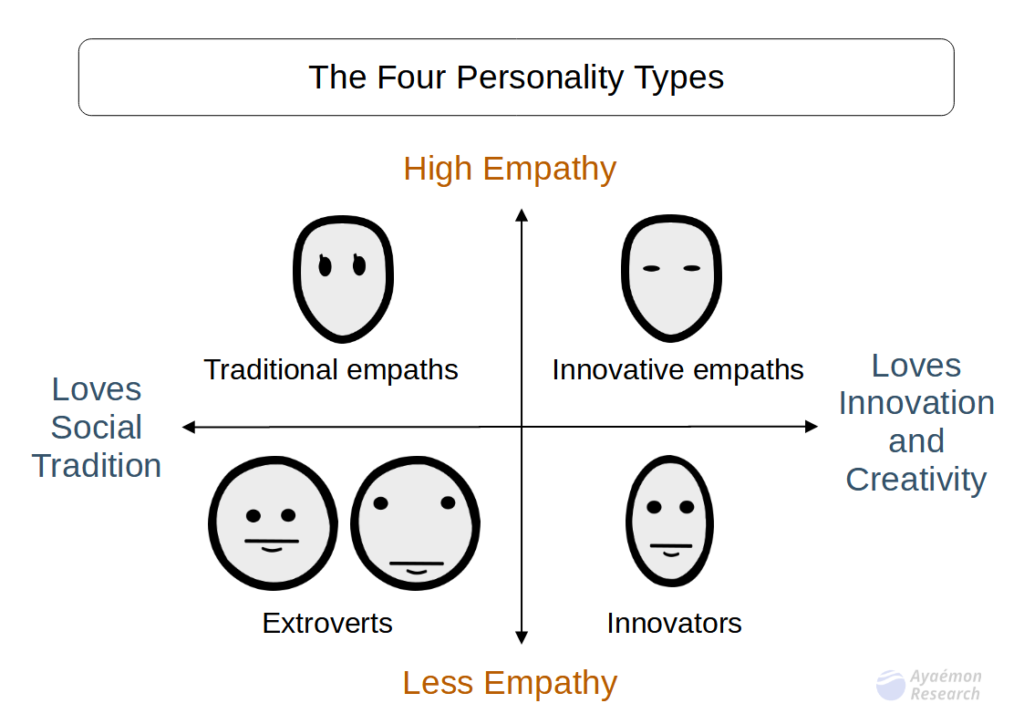
We classify our personalities based on two axes. One axis is whether they are highly empathic or less empathic. The other is whether they prefer following social tradition or trying new ways.
Four styles of sense
In other words, we could have four kinds of social sense: competition, sociality, empathy, and logic. It is as follows:
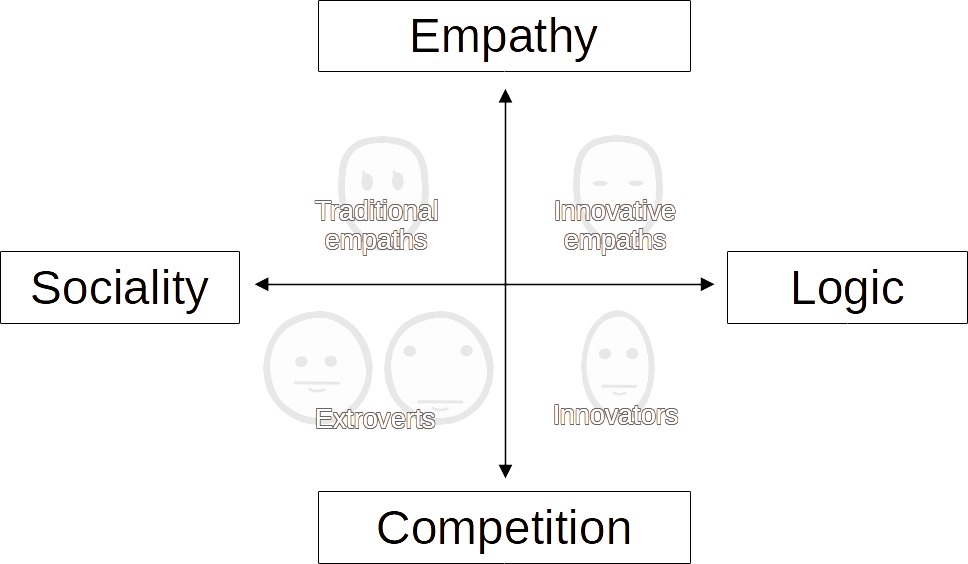
They are like a language to communicate. Usually, we cannot communicate with others with different senses because we cannot understand their thoughts or wants. We see such people as incomprehensible people.
However, those four social senses allow us to communicate with people with other personalities. The common sense between us allows us to understand each other.
Four types of biased personalities
There are four types of personalities, as follows:
- Extroverts: People who are biased toward competition and sociality. They are the social majority.
- Traditional empaths: People who are biased toward sociality and empathy.
- Innovative empaths: People who are biased toward empathy and logic. They are the social minority.
- Innovators: People who are biased toward logic and competition.

Communication with their sense
Those styles allow each personality to communicate with another type.
For example, traditional empaths can communicate with innovative empaths through empathy. They both have empathic senses. That allows them to understand each other in that area. They talk about things related to empathy, such as emotions, imagination, dreams of the future, or consideration toward others.
With extroverts, traditional empaths use a common sense of them: sociality. They talk about social topics or trends based on social values.

Innovators communicate with extroverts through socially competitive topics. For example, they often compare and argue about which is socially better.
Innovators communicate with innovative empaths through logic. For example, they talk about why it happened or the logic to solve their problems.
Try checking conversations on SNS while being aware of the above tendency. You will soon find they have that tendency. Those styles allow them to communicate with others with other personalities.
Why innovative empaths are bad at extroverts
In other words, the opposite personalities in X-shaped relationships are hard to communicate with because they have different social senses.

For example, innovative empaths often find it hard to communicate with extroverts. Innovative empaths try to explain something with empathy and logic. On the other hand, extroverts can understand only sociality and social competition. That prevents them from understanding each other.
It is the same for the relationship with traditional empaths and innovators. It is hard for them to communicate due to the difference in their senses.
The nature of the inferiority complex
That incomprehension is the source of our inferiority complex. Although there is no perfect personality, we misunderstand to be able to do perfectly if we are confused with those values.
That is why an inferiority complex always makes us pursue perfection, which ruins us. We misunderstand and try to have a perfect personality.

On the other hand, mentally healthy people know that there is no such a perfect personality. Personalities are the same as roles. They try to play their roles at their best based on their biased personalities. In addition, each personality has acceptable failures that give us growth. That is healthy perfection.
Perhaps our environment in childhood created such a misunderstanding.
The place where the inferiority complex appears
That determines the area of our inferiority complex. It is always the opposite of our inherent personalities because we don’t have those senses. To be precise, it will be point symmetry.
For example, if we are innovative empaths, the inferiority complex will be the opposite: toward extroverts, as shown in the following figure. Perhaps you can easily understand this.
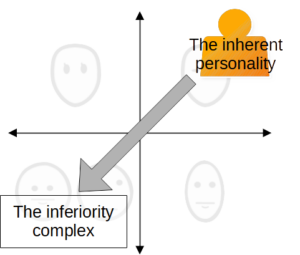
The case of intermediate on an axis
If our personality is intermediate between traditional and innovative empaths, the inferiority complex will be the opposite: intermediate between extroverts and innovators. It is as follows:
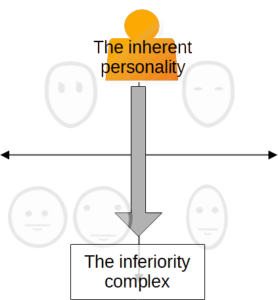
In this case, the person with this personality tends to be highly empathic and has moderate sociality and logical sense. The inferiority complex is toward only social competition.
The case of intermediate on both axes
In the case of intermediate on both axes, he tends to feel less individual, although the person can go along well with everyone. In other words, he has an inferiority complex toward people with biased personalities, as shown in the following image:
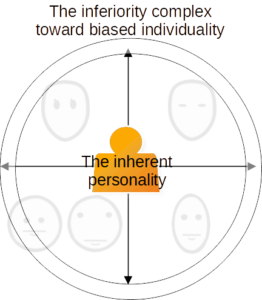
The wall of the environment
Our environment also has personalities. That confuses us about values if we are in an inappropriate environment because we can see only the negative aspects of personalities.
Perhaps an example makes it easier to understand. Assume we are innovative empaths and in an inappropriate environment that values being extroverts. It is like the image below:
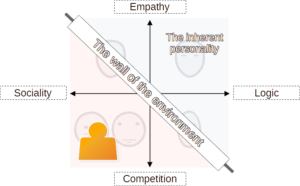
In such an environment, we are confused about values. All personalities look negative because everyone communicates with us through sociality and social competition. Traditional empaths use sociality sense. Innovators use competition sense. That makes it hard for us to get along with all of them. It makes us feel lonely and helpless.
It is like a wall. The wall of the environment hides another side of personality.
The sense of the side of the inherent personality
If we migrate to another environment with the other side, the side of the inherent personality, we will suddenly find we can easily communicate with traditional empaths and innovators. It is as shown in the following image:

This is because we can use empathy and logical sense. That frees us from confusion about values and makes us feel comfortable.
We feel neither lonely nor helpless. We understand the role to play in the environment. Although we have to give up the role of extroverts, we can contribute to others. That brings us allowance to exist and happiness.
If we keep that in mind and try to find a better environment, we will suddenly solve our mental problems at some point.
Conclusion
The above is the nature of the inferiority complex.
Those concepts might give us a way to understand and solve our inferiority complex.
Thank you for reading this article. I hope to see you in the next one.


